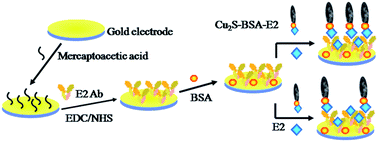An ultrasensitive electrochemical immunosensor for determination of estradiol using coralloid Cu2S nanostructures as labels†
Abstract
Herein, coralloid Cu2S nanoparticles were prepared through a facile etching method and used as labels for the first time to fabricate an electrochemical immunosensor. A novel competitive immunoassay was then proposed using Cu2S covalent conjugation with bovine serum albumin (BSA)–estradiol (E2) for the sensitive detection of trace E2 concentrations. Without using enzyme-label and acid dissolution, the Cu2S can generate excellent electrochemical signals. The quantitative detection was based on the competitive binding of the E2 antibody with Cu2S-labeled E2 or free E2. The redox signal decreased with increasing concentration of the free E2 as the amount of Cu2S–BSA–E2 labels decreased at the immunosensor probe. Cyclic voltammetry and electrochemical impedance spectroscopy techniques were used to characterize the immunosensor. Square wave voltammetry was used to monitor the electrochemical response. The immunosensor exhibited a wide linear response from 25 to 7500 pg mL−1 with a detection limit of 7.5 pg mL−1. The proposed method showed good precision, broad linear range, and acceptable stability and could be used for the detection of E2 in real samples, which showed promising application in field research.


 Please wait while we load your content...
Please wait while we load your content...